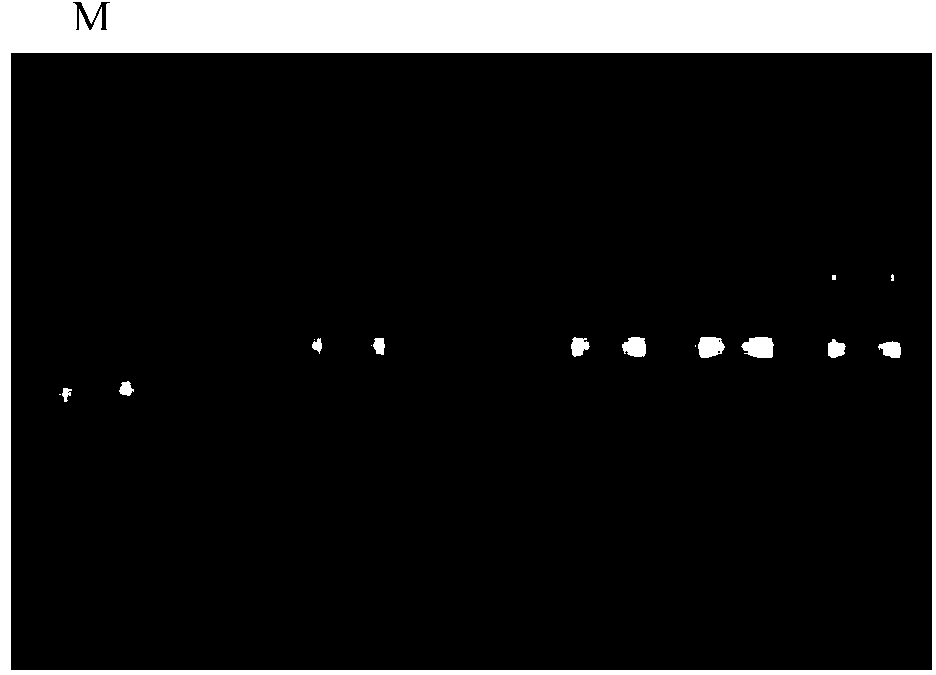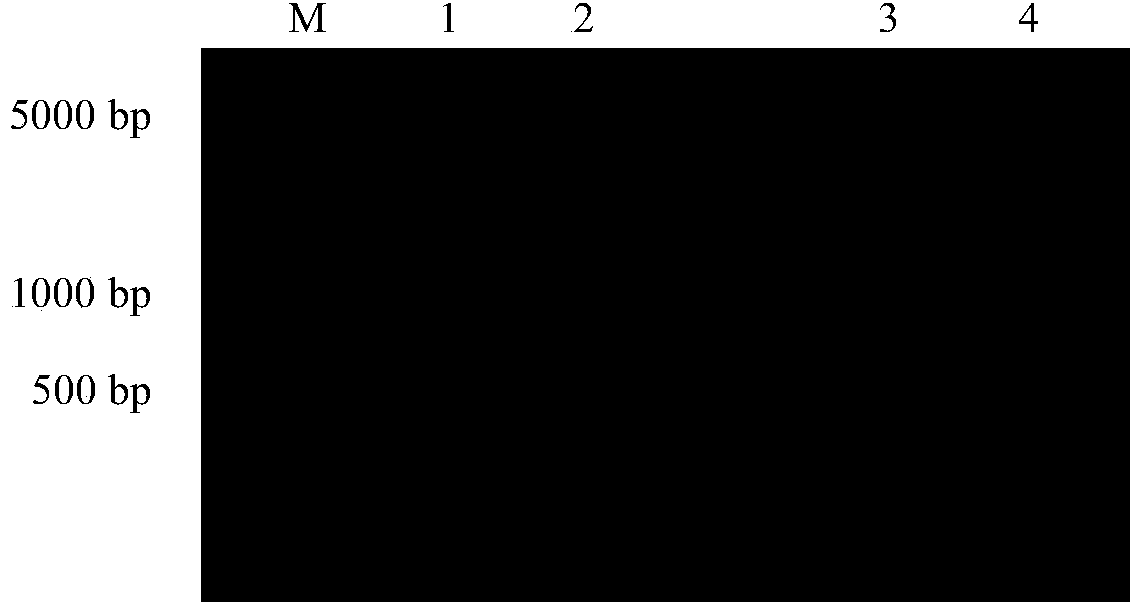RNA interference vector of bactrocera dorsalis sodium ion channel genes and construction method and application thereof
A technology of sodium ion channel and RNA interference, which is applied in the field of genetic engineering to achieve the effect of reducing the amount of use and broadening the market prospect
- Summary
- Abstract
- Description
- Claims
- Application Information
AI Technical Summary
Problems solved by technology
Method used
Image
Examples
Embodiment 1
[0042] Example 1 Cloning and recovery and purification of sodium ion channel genes
[0043] 1. Extraction of Bactrocera dorsalis total RNA and acquisition of full-length cDNA
[0044] Total RNA from the Bacteralis dorsalis source provided by the Plant Protection College of Southwest University was extracted using a total RNA extraction kit. For specific steps, refer to the instructions of the total RNA extraction kit. The extracted total RNA electrophoresis figure 1 shown.
[0045] The extracted total RNA was reverse-transcribed into cDNA using the PrimeScriptTM RT reagent kit with gDNA Eraser reverse transcription kit. For specific steps, please refer to the instructions of the reverse transcription kit.
[0046] 2. Cloning, recovery and purification of the target fragment of the sodium ion channel gene
[0047] (1) Search the full-length sequence of the Bacteralis dorsalis sodium ion channel gene on the NCBI website, compare the conserved sequences, and design the forward...
Embodiment 2
[0056] Embodiment 2 Transformation of recombinant plasmid
[0057] 1. In vitro ligation of target fragment and plasmid
[0058] The forward target fragment and the reverse target fragment of the sodium ion channel gene recovered in Example 1 were respectively connected to the carrier pMD-19 in vitro, and the reaction system (10 μL) was as follows:
[0059] pMD-19Vector 0.5μL
[0060] Insert DNA 4.5μL
[0061] Ligation Solution 5μL
[0062] The above operations are best performed on ice. After adding the drugs, put the mixture into a PCR machine and connect overnight at 16°C to obtain two recombinant plasmids of the forward fragment and the reverse fragment of the sodium ion channel gene. The recombinant plasmid of the fragment was named pMD-19-C1R1, and the recombinant plasmid of the reverse fragment was named pMD-19-C2R2.
[0063] 2. Transformation of Escherichia coli with recombinant plasmids
[0064] Transform the recombinant plasmid pMD-19-C1R1 of the forward fragment...
Embodiment 3
[0074] Example 3 Construction of RNA interference expression vector
[0075] 1. Ligation of the target fragment with the vector PFGC5941
[0076] (1) Carry out double digestion with XhoI and NcoI of the forward target fragment plasmid pMD-19-C1R1 of the sodium ion channel gene extracted in Example 2 and the carrier PFGC5941 respectively. The enzyme digestion system is: Buffer45μL, XhoI1.5μL, NcoI1.5μL, BSA0.5μL, pMD-19-C1R1 or PFGC594120μL, with ddH 2 O Adjust the total volume of the enzyme digestion system to 50 μL, put it into a centrifuge tube, and bathe in a water bath at 37°C for 4 hours.
[0077] (2) Take 3-5 μL of the digested product of pMD-19-C1R1 and carrier PFGC5941 obtained in step 1 for electrophoresis detection, and run the recovery gel to recover the digested product. The electrophoresis of PFGC5941 digested by XhoI and NcoI is as follows: Figure 4 As shown, the electrophoresis of pMD-19-C1R1 digested by XhoI and NcoI is as follows Figure 5 shown.
[0078...
PUM
 Login to View More
Login to View More Abstract
Description
Claims
Application Information
 Login to View More
Login to View More - R&D
- Intellectual Property
- Life Sciences
- Materials
- Tech Scout
- Unparalleled Data Quality
- Higher Quality Content
- 60% Fewer Hallucinations
Browse by: Latest US Patents, China's latest patents, Technical Efficacy Thesaurus, Application Domain, Technology Topic, Popular Technical Reports.
© 2025 PatSnap. All rights reserved.Legal|Privacy policy|Modern Slavery Act Transparency Statement|Sitemap|About US| Contact US: help@patsnap.com



